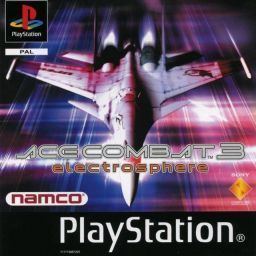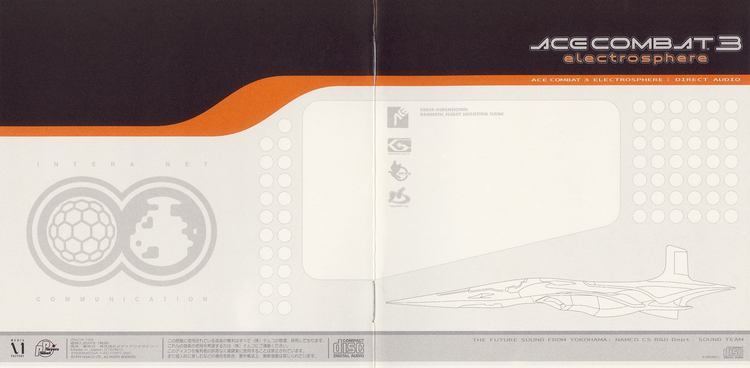8.4 /10 1 Votes
4.8/5 CoolROM Producer(s) Takashi Fukawa Mode Single-player video game | 4.6/5 Emuparadise 6.2/10 GameSpot Initial release date 27 May 1999 | |||||||||||||||||||||||||||||||||
Distributor(s) EU: Sony Computer Entertainment Europe Director(s) Takuya IwasakiAtsushi Shiozawa Composer(s) Tetsukazu NakanishiKoji NakagawaHiroshi OkuboGo ShiinaKanako KakinoTomoko Tatsuta Release date(s) JP: May 27, 1999EU: January 21, 2000NA: March 2, 2000 Genre(s) Arcade, Combat Flight Simulator Similar Ace Combat games, Namco games, Flight simulators | ||||||||||||||||||||||||||||||||||
Psx longplay 252 ace combat 3 electrosphere
Ace Combat 3: Electrosphere (エースコンバット3 エレクトロスフィア, Ēsu Conbatto San Erekutorosufia) is a flight simulation game made by Namco for the PlayStation game console. The third installment in the Ace Combat series of console flight simulation games, Electrosphere takes the contemporary setting of the first two games into a story set in the mid-21st century, involving a war between multinational corporations.
Contents
- Psx longplay 252 ace combat 3 electrosphere
- Ace combat 3 electrosphere retro review
- Plot
- Gameplay
- Aircraft
- Development history
- Reception
- References

The game is notable for having two radically different releases for the Japanese and Western markets. The Japanese version of Ace Combat 3 released in 1999 featured a lengthy 2-disc campaign of 52 missions that were split among different paths depending on in-mission decisions, along with multiple endings and multiple factions for the player to join. It also featured fully voiced anime cut-scenes, along with in-game radio chatter.

The international version of Ace Combat 3 was released in 2000. While nothing was changed from the overall gameplay, its campaign was stripped down to a 1-disc 36 mission campaign with no branching paths. English voice acting was planned and started recording in the early stages, but Namco cut the funding for the translation efforts. While Namco never officially explained why this occurred, many speculated it was due to sales being lower than expected for the Japanese release, along with the impending release of the PlayStation 2. To accommodate for the Japanese plot not being translated, all story related voice acting and cut-scenes were removed, along with the plot being rewritten to a more basic story with no voice acting. While the international version still received critical acclaim for its gameplay and graphics, the decision to remove most of the plot was heavily criticized by Western critics and gamers, since Namco initially advertised that the Western release would featured all the content seen in Japanese version.
Ace combat 3 electrosphere retro review
Plot
The plot, which takes place on the Usean continent sometime in the first half of 2040, involves two megacorporations – Neucom Inc and General Resources Ltd. These two companies fight over territorial disputes and eventually a prototype fighter known as the X-49 Night Raven, with the Universal Peace Enforcement Organization trying to placate both sides.
Gameplay
The game features a single-player mode, where the player can open a new campaign under a specific username. Depending on actions made at some points in the campaign, the plot shifts towards one of five endings. Some walkthroughs can be finished on disc one, but longer campaigns will continue in disc two. The game introduced a third-person 360-degree camera that could be rotated on all three axis with the right thumbstick, and a camera that can focus on the player's current target by holding the Triangle button. While the five endings concern the final fates of certain characters, a sixth ending suggests that the game itself is a simulation program, and the success of which forces the program creator to delete all files.
The player's performance in each mission is graded from D to A with corresponding colors, A being the highest at red. The title screen also has a chart where the player's performance across all missions and difficulties is logged.
The Japanese version of the game contains an in-game encyclopedia where the player can view various information on the game's characters and technology. It also features anime-style video e-mails with full voiceovers from non-player characters, which can be replayed in an inbox, as well as anime cutscenes.
Aircraft
The game has 23 playable aircraft (21 for the North America/Europe version) spread out across four factions. Some of them are real-world military aircraft that have been redesigned specifically for the game's futuristic setting (with the most obvious aesthetic being the heavily streamlined cockpit area to reflect the so-called COFFIN cockpit system), while others are all-original concept designs. Space vehicles became playable for the first time in the series, with players getting to fly the R-352 Sepia spaceplane for one orbital mission.
Unlike the first two games, however, players can only choose a limited number of planes (and weapons) for the first few missions, but will stick only to one plane for the latter stages. All flyable planes are eventually unlocked in the Mission Simulator, which is activated when all endings in the game have been obtained.
Development history
The game was an attempt to explore the future of the Ace Combat universe. Concept images first surfaced in 1998 and continued through early 1999.
The majority of the songs were done by Tetsukazu Nakanishi, who would later go on to contribute background music for most of the succeeding Ace Combat console games.
The Japanese version of the game was released on May 27, 1999. Along with the 26-page instruction manual, this contained a 30-page booklet called "Ace Combat 3 Electrosphere Portfolio Photosphere," which details the game's characters, fighter planes, and other information about the game world. The "PlayStation the Best" reissue did not contain this booklet. The original game was later re-released for the Japanese market on December 7, 2000 as part of Namco's "PlayStation the Best" line of best-selling PSOne games.
Ace Combat 3 takes place in Namco's United Galaxy Space Force universe, which also includes many of their previous science-fiction games.
Reception
On release, Famitsu magazine scored the game a 31 out of 40.
GameSpot graded the North American release at 6.2 out of 10. Reviewer James Mielke said the game's high production values were evident, but Namco's non-inclusion of the Japanese version's content in the final release was a surprise considering months-long gap after the original release.
